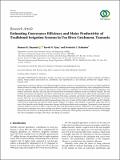| dc.description.abstract | This study investigated the economic viability of Micro Irrigation
Technologies (MITs) compared with traditional furrow irrigation in smallholder
horticultural farming in northern Tanzania. Using a quasi-experimental cross-
sectional design, data were collected from 540 farmers, divided into adopters
and nonadopters of MITs. Economic metrics, including net present value (NPV),
the benefit‒cost ratio (BCR), and the internal rate of return (IRR), were analysed
over a five-year investment horizon through statistical methods in SPSS and
Microsoft Excel. The results indicate that MITs, particularly drip and sprinkler
systems, increase the productivity and profitability of high-value crops such as
onions and tomatoes, yielding significantly higher NPVs than furrow irrigation
does. Despite their high initial costs, these technologies demonstrated long-term
economic benefits, including improved water efficiency and labour cost savings.
Regression analysis further revealed that both crop type and irrigation
technology significantly influence economic outcomes. Onions and tomatoes
under MIT presented the highest financial returns, whereas peppers under
furrow irrigation achieved better cost efficiency. This study underscores the
transformative potential of MITs in enhancing horticultural productivity and
sustainability in water-scarce regions. The study recommends targeted
interventions, including subsidies, financial incentives, training programs, and
policy support, to scale up the adoption of MITs. | en_US |




